Rare Mastiff Dog Breeds
The rare mastiff dog breeds are large and powerful dogs often referred to as giant dog breeds. They are also considered to be among the more exotic and unique breeds.
All of these tags certainly fit and contribute to the fact that the cost to obtain
one is usually quite high.
Origins Of The Mastiffs
While mastiffs have been bred for centuries for various purposes, their origins are somewhat unclear. According to some experts the dogs may have originated in Asia or the Middle East.
The American Kennel Club says that images of the Mastiff may be seen on Egyptian
monuments dating back to 3000 BC.
Wherever the dogs came from, they were in Persia and Turkey by 485 BC when Xerxes brought them from there
into Greece.
These large dogs were more than likely used to guard flocks and herds.
 Where Did Mastiffs Originate?
Where Did Mastiffs Originate?Ultimately, "they" became the ancestors of later war dogs and sheepdogs. Dogs from the Molossia region gave their name to Molossers, a term still used to describe many mastiff-type dogs.
The Mastiff Dog Breeds Diversity
Early on, differences were developing among the mastiffs. Some were being used as shepherds (white with longer
muzzles) and the darker, heavier dogs being used in battle.
From these diverse dogs came the Great Pyrenees, the
Dogue de Bordeaux, the Neapolitan Mastiff and many other dogs we still know today, as well as the Mastiff originating in
England.
Along with being guard dogs the Mastiff became a powerful hunting dog used to hunt bear and wolf.
Some mastiff-type dogs were also used for bull-baiting and dog fighting.
The Roman Influence
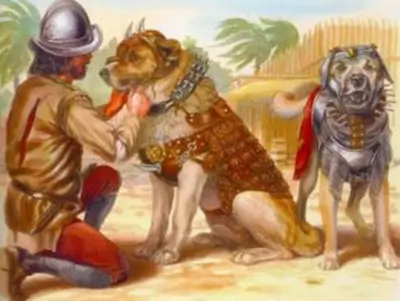 Early Mastiff Dogs of War
Early Mastiff Dogs of WarThere are countless descendants of the ancient mastiffs today, spread throughout many dog breeds.
As the Romans expanded their empire into various regions, they often brought along their mastiffs which stimulated significant interest in these powerful dogs.
This led to the breeding of distinct mastiff variations in many of these areas.
For instance, in Gaul, locals changed the Roman mastiffs into the Alpine Mastiff and later the St. Bernard.
The Rare Mastiff Dog Breeds
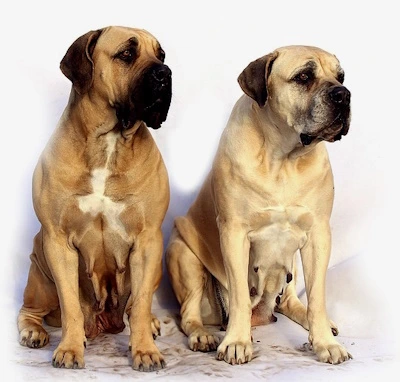 Mastiff Dogs courtesy Pixabay
Mastiff Dogs courtesy PixabayToday there are many mastiff breeds that are thriving, such as the St. Bernard, the Great Pyrenees and the Mastiff from England.
But
there are also a number of mastiff breeds which are either nearly extinct or which have been revived and are
attempting a comeback.
Some of these breeds are known only in Europe. In some cases the breeds were wiped out by
World War I and II. In other cases, the numbers have simply dwindled due to a lack of breeders.
So let's explore some of the rare mastiff breeds we know about today.
American Mastiff
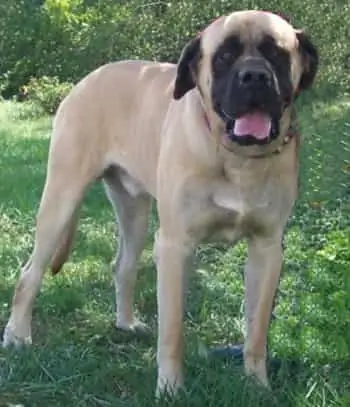 Courtesy M Parlier
Courtesy M ParlierThe American Mastiff dog breed (AM) originated in the United States and was developed over several years through a cross of the English Mastiff and the Anatolian Mastiff resulting in a dog that can weigh up to 200 pounds or more.
The AM breed is registered with the Continental Kennel Club and has been recognized as a purebred breed by them since 2000.
Their overall appearance is that of
a massive, impressive-looking powerful dog
bearing a very similar resemblance to the English Mastiff.
While many may be overawed by an American Mastiff, this large dog is known to be a very loyal, extremely family-oriented breed.
The AM is a patient and gentle dog and has a reputation for getting along well with children. Once socialized they will be friendly with family friends and guests.
Though not aggressive, as a family protector, the AM's commanding appearance, standing at 3 feet tall, would make any potential intruder think twice before proceeding.
Families interested in welcoming an American Mastiff puppy or rescue should ideally have plenty of space for exercise and play and be experienced dog owners - particularly with similar sized dog breeds.
A list of breeders can be found here.
Because of the large size this dog will become, it's important that puppies be trained and well-socialized from an early age to accustom them to a wide variety of experiences, places and situations including interactions with people and other dogs.
Regarding health, the not uncommon issues, which an informed vet will know how to treat, include:
- not surprisingly- hip dysplasia
- and bloat
Families of the AM that provide good care and nutrition, plus the benefit of regular veterinary oversight can expect to enjoy their Mastiff for between 8 to 12 years.
Anatolian Shepherd Dog
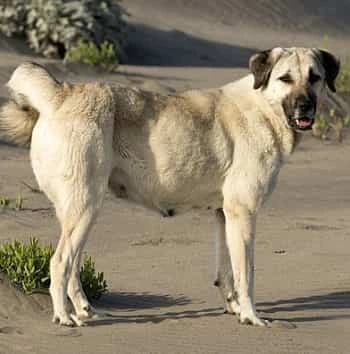 Courtesy Z Cebeci
Courtesy Z CebeciThe Anatolian Shepherd dog is descended from ancient mastiff breeds. He is primarily a livestock guarding dog with a strong independent nature.
Also known as
Anatolian Karabash and Turkish Shepherd Guard Dog, the breed originated in Turkey as far back as the Persian Empire.
Historically this breed has a long been recognized as a top mastiff-type flock guardian being renowned for their strong protective instincts and ability to fend off predators.
Anatolians have an affectionate nature and as family companions, one could not wish for a more loyal and protective dog. They get along well with children and other pets.
However, due to responsibilities of working for decades to protect their flocks, it is not surprising that they have acquired an independent streak along with the confidence needed to make decisions.
For this reason, they must be well-socialized and trained from an early age with a self-assured strong leader they can respect and bond with.
Socialization and consistent training are essential to most breeds to become solid canine citizens. This is especially crucial to large dominant dogs such as the Anatolian.
In terms of appearance, the Anatolian Shepherd dog is a very large, well-muscled and powerful-looking dog breed that can weight up to 150 pounds with a height of up to 30 inches.
Along with a dense double coat, these sturdy dogs are ideally suited to perform their outside job duties.
Health: To maintain the overall good health of this breed:
- Provide high quality food and water at all times,
- Take him for daily walks,
- Routinely check ears and brush teeth.
- Arrange annual check-ups including dental inspection with a veterinarian.
While not commonly disposed to hip dysplasia and bloat, owners should be informed of these conditions just in case - especially to the latter which can be life threatening.
Additionally, this breed may acquire an eyelid condition known as entropian. It is good for your vet to be familiar with these health notes as well as the breed's sensitivity to anesthesia - in case any procedures require this - such as teeth scaling.
For more extensive information about this very interesting breed I have created a separate page for the Anatolian Shepherd dog here.
Bullmastiff
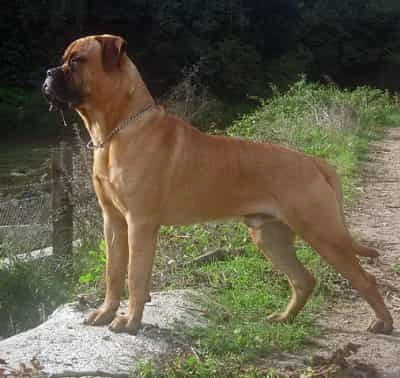 Courtesy F.Moreno
Courtesy F.MorenoThe Bullmastiff, one of the rare mastiff dog breeds, was developed in England during the 19th century and is believed to be a cross between two native breeds - the English Mastiff and the Bulldog.
The Bullmastiff breed was recognized by the AKC in 1934.
Background of the Bullmastiff
William Burton of Thorneywood Kennels bred an early version of the Bullmastiff.
One of his dogs, known as Thorneywood Terror, became famous at gamekeepers’ shows for his ability to catch any person willing to bet that he could escape from the dog.
Even with the better being give a head star, the dog always caught and toppled the unfortunate gambler!
This mastiff breed is highly protective but not aggressive, fearless, intelligent, very strong and impressively agile for its large size.
Ultimately, these attributes were put to use on large English estates where the Bullmastiff accompanied gamekeepers on night patrols to catch poachers and prevent the rustling of game which was pretty common at the time.
While poaching was a very serious crime, many intruders were undeterred and the game wardens needed more protection in doing their job..
Enter the Gamekeeper’s Night Dog, as the Bullmastiff became known.
A large muscular dog weighing up to 130 pounds and standing up to 27 inches at the shoulders, is definitely capable of making quite an impression on potential trouble makers!
Characteristics
Today, having left his original job far behind him, the Bullmastiff dog breed has moved on to a less stressful role as a cherished family member, who enjoys companionship.
The Bullmastiff is known for his intelligence and alertness. These attributes, along with being a very confident dog has earned him the reputation as a vigilant and fearless family protector.
While he will alert you to potential danger, he's not known for unwarranted barking.
That being said, while Mastiffs make great family companions, being both gentle and affectionate, they do need early training and socialization due to their large size and protective nature.
This is crucial and bears repeating as they can be strong willed, even as a puppy.
Activity Level
Daily exercise is a must for all dogs and Bullmastiffs are no exception. They do enjoy a brisk walk but the duration can vary between dogs, some being naturally less active than others.
Exercise should not be excessive
while puppies are experiencing fast growth spurts to avoid undue stress on developing bones.
Outdoor play in a secure area can also be a fun part of their routine.
Bullmastiffs, being an agile breed, do well in other activities including agility which could be an ongoing experience for both dog and pet parent to enjoy.
For mentally stimulating this intelligent dog, look into obedience, rally, even scent work and tracking and start them young.
Coat and Grooming
The Bullmastiff has a short coat that comes in fawn, red, or brindle.
Monthly routine grooming with a hound glove will suffice. Also clean up the facial folds and ears, brush his teeth and clip nails when necessary.
This breed is a drooler, so you will need to be prepared to handle this in your own way.
Health Notes
Health issues common to large breeds include hip and elbow concerns as well as bloat – a very important life-threatening condition to be aware of.
Lifespan of the Bullmastiff is beteen 7 to 9 years, but some have lived up to 12 years.
Overall care should include regular exercise, sound nutrition, and veterinary check-ups on an annual basis to maintain health and a contented life.
Cane Corso
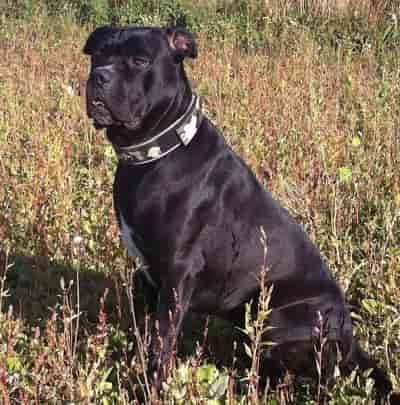 Courtesy Creative Commons
Courtesy Creative CommonsThe Cane Corso, also referred to as the Italian Mastiff, is a breed which originated in Italy with a history that goes back to Roman times.
To be clear, this breed is the result of Italian native dog breeds crossed with Mollosus (mastiff) type dogs obtained during the Roman occupation of the Greek Islands.
Subsequently, after all the fighting was over in the Western Empire, the dogs took on other jobs around farmhouses including herding or guarding cattle and pigs, wild boar hunting, as well as protecting their owners property.
Overtime, their numbers diminished greatly that they almost vanished, but were brought back from near extinction by a group of fanciers in the 1970s. A Society of Cane Corso Lovers was formed in 1983.
Appearance:
The Cane Corso has a short dense coat seen in
black, gray, fawn, or brindle. The breed is very muscular and can weigh between 100-120 pounds with a height of up 28 inches tall at the withers.
Their ears are often cropped though in come countries this is not allowed.
Characteristics:
A loyal and protective breed that likes to keep in close touch with their owners and other family members most of the time. This also means, they don't like being left alone!
Training can be pretty straightforward if an owner has a strong background in dog training because the CC is very intelligent but can have the tendency to try to take charge.
The solution to this tendency is an experienced owner to provide firm guidance and thoroughly socialize the Cane Corso to build their comfort level around people, places and multiple situations - from a very early age.
Daily Activity:
Cane Corsos need significant exercise. If you enjoy speed walking or running, the CC will be more than happy to go along.
Without sufficient exercise, he will develop bad behaviors. Cane Corso are from a working heritage and jobs are what he needs. .
In addition to a large outdoor area for play, exercise and training, the CC should be taken out for exercise a couple of times a day for his well-being and mental stimulation.
Health:
Overall the Cane Corso is considered a fairly healthy breed. That being said, there are some health issues associated with them. Those include:
- Hip dysplasia,
- Idiopathic Epilepsy,
- Mange,
- Eyelid issues, and
- Bloat, owners need to know the signs of this life threatening condition
Life expectancy of the breed is between 9 to 12 years, with the benefit of good care and nutrition, plus regular vet visits for check-ups.
AKC Recognition:
The Cane Corso Came to America in 1988, and in 2010 the breed was recognized by the AKC as part of the
Working Group of dogs, or Mollosus breeds
.
Dogue de Bordeaux
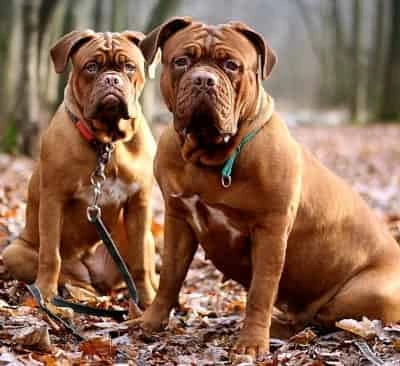 Courtesy Pixabay
Courtesy Pixabay
Originating in France, the Dogue de Bordeaux (DDB), is a large breed originally used for guarding estates and later to drive cattle as well as for hunting purposes.
The breed also goes by other names including the Bordeaux Mastiff or French Mastiff and is generally considered to be one of the oldest of the mastiffs.
Appearance:
The Dogue de Bordeaux is a very powerful dog with males weighing from 110 pounds or much more and standing up to 27 inches at the withers.
The DDB has a short, attractive coat that is seen in shades of fawn. Their forehead is quite furrowed, and their jowls are thick and hang quite low.
Characteristics:
Despite their
formidable appearance, Dogue de Bordeauxs are generally gentle and
affectionate with their families.
They are loyal, protective, and often described as "nanny dogs" due to their love for children. However, they can be stubborn and require a confident leader who can provide firm and consistent training from an early age.
Proper socialization is also important to ensure they are comfortable in a variety of situations, places, around strangers and of course other dogs.
Dogue de Bordeauxs require a lot of space and exercise to stay healthy and happy.
Health:
Issues that may affect this breed during their lifetime include hip dysplasia and heart conditions, which can be managed
through regular veterinary care and proper nutrition.
Sadly, they have a relatively short life of between 5-8 years.
Overall, the Dogue de Bordeaux is a loyal and devoted companion for the right owner who is willing to provide the care and attention they require.
The breed
was recognized by the AKC in 2008.
English Mastiff
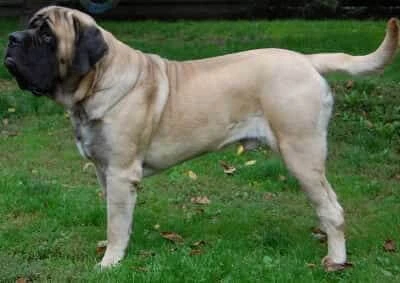 Westgort by R.Rohovsky
Westgort by R.RohovskyThis breed is part of the Molosser group originating in England and is usually just known as "Mastiff".
The English Mastiff is one of the oldest dog breeds with a history dating back to ancient times. The breed was originally used as a guard dog and for hunting large game.
At one time the EM was used for bear-baiting, bull-baiting, dog fighting and even lion-fighting.
By the end of World War I the breed became extinct outside the UK. Since that time, the breed has become much more popular in the U.S. and around the world.
Appearance:
English Mastiffs are very large, with males typically weighing between
160-230 pounds and standing up to 30 inches tall at the shoulders.
They have an impressive size head with a black mask around the short muzzle, droopy jowls, and a wrinkled forehead.
Their coat is short, smooth and tight to the body. Colors seen in the coat include apricot-fawn, silver-fawn, fawn, or dark fawn-brindle
Characteristics:
Despite their commanding appearance and size, the EM is generally a gentle and
affectionate dog around their families. They are loyal, protective, and
often described as "gentle giants".
However, there is a bit of a stubborn streak in the breed which can be counteracted in the hands of a firm yet fair leader who can provide consistent training from an early age.
Proper socialization is an important part of the EM's handling to make sure they are comfortable in a variety of situations, around strangers and other dogs.
Space Needs:
As can be expected, the English Mastiff's large size is best suited to a lot of space where he can get some daily exercise in addition to daily walks.
Health:
The issues English Mastiffs may encounter during their lifetime include, not surprisingly:
- Hip dysplasia
- Bloat
The latter is a very serious issue which you can learn more about here.
The English Mastiff has an lifespan between 6 to 10 years, but some have lived much longer. One record exists of an EM named Kush living to age 15.
Regular veterinary oversight, exercise and good nutrition definitely play an important part in raising a healthy Mastiff.
Great Dane
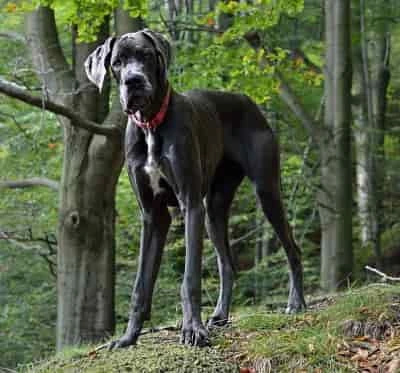 Great Dane credit Pixabay
Great Dane credit PixabayThe Great Dane is an old breed that traces its history back to 3,000 B.C where depictions of similar “mastiff” type dogs have been discovered in artifacts and writings.
At that time, the GDs, prized for their fearless nature, strength and boldness were used as war dogs as well as for hunting boar and guarding property.
Over time, both their appearance and demeanor changed considerably as a result of being selectively bred in different countries.
The Great Dane (English translation), as we know it today originated in Germany where it is known as Deutsche Dog and is also known as the German Mastiff and Grand Danois in French.
There is no connection of the breed with Denmark.
It is speculated that the development of the GD resulted from a cross between the Mastiff and the Irish Wolfhound.
The secondary influence was from the greyhound which gave the Great Dane is regal and svelte appearance.
The United States began importing dogs, primarily from Germany and the breed was officially recognized by the American Kennel Club in 1887.
Ultimately a specialty breed club was organized in 1889, which evolved into The Great Dane Club of America in 1891.
Appearance:
Great Danes are not only elegant they are also among the largest dog breeds, with males weighing between 120-200
pounds and standing up to 32 inches tall at the shoulders.
They have a sleek, muscular build with a long, narrow head and floppy ears. Their coat is short and comes in a variety of colors, including black, blue, fawn, brindle, and the best known black and white patchwork referred to as "harlequin."
Characteristics:
Although they are impressively large, Great Danes are known for being gentle and affectionate with
their families, and they are often referred to as "gentle
giants".
They are generally good with children and other pets, and they tend to have a laid-back and calm temperament.
However, they do require proper socialization and training from an early age to ensure they are well-behaved around strangers and other dogs.
Exercise Needs:
Great Danes require regular exercise and space to
roam, but they are generally considered low-energy dogs. They enjoy a few leisurely
walks each day and playtime, but are also content to lounge around the house with their
owners.
Due to their size, it's important to avoid overexertion up to two years of age, as this is a significant growth phase when their developing joints need protection.
Health:
The Great Dane is prone to certain health issues.
These include:
- Hip dysplasia, not uncommon in both large and small dogs,
- and bloat, which can be managed through careful feeding oversight, proper nutrition and regular veterinary care.
Health Tests Recommended by the National Breed Club:
- Hip Evaluation
- Thyroid Evaluation
- Cardiac Exam
- Ophthalmologist Evaluation
Professional breeders should have these tests results available when offering puppies for sale.
Life expectancy of the Dane is between 7 to 10 years with the benefit of good care and nutrition plus veterinary oversight on a regular basis.
Overall:
The Great
Dane is a gentle and affectionate breed that can make a great
companion for the right family with enough space and time to devote
to their needs.
Japanese Mastiff
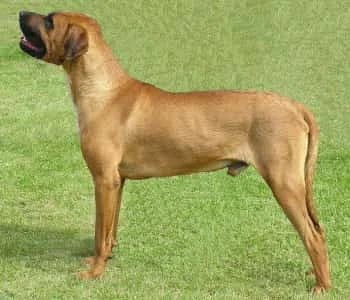 Courtesy L.Houdas
Courtesy L.HoudasAll of the rare mastiff dog breeds are very big muscular dogs as we know, but this one stands out as being extra large.
Origins:
The Japanese Mastiff,
also known as Tosa Inu, or simply Tosa, originated in Japan.
Breeds used for in the development and improvement of the Tosa include Bulldogs in 1872, Mastiffs in 1874, German Pointers in 1876 and Great Danes in 1924.
There are also some references to Saint Bernards and Bull Terriers being involved, but no time period is cited.
They were originally bred for dog fighting in the late 19th century, but today they are primarily kept as companion dogs in their home country and around the world.
Appearance and Grooming:
The Japanese Mastiff is not only powerful, but can weigh as much as 200 pounds and stands
up to 32 inches tall at the shoulders.
The head is large with a strong jaw, and their ears are often cropped for aesthetic purposes.
They have a short, double coat that comes in a variety of colors, including red, fawn, brindle, and black. Shedding is moderate and the coat requires only occasional brushing.
The Tosa has strong nails that grow fast and need to be clipped about every two weeks often to prevent damage. Inspect the ears for any removal of debris and brush teeth often.
Also be aware that this breed does drool and while this is natural, it is another aspect of grooming.
Characteristics:
The Tosa Inu is an alert, intelligent dog known to be both fearless and courageous while having a calm disposition, Due to their history
as fighting dogs, Japanese Mastiffs can be wary of strangers and
other dogs.
They require a firm and experienced owner who can properly train and socialize them from an early age. Despite their history, they are generally loyal and affectionate with their families, and they are known for quiet nature.
Exercise Needs:
Japanese Mastiffs
require daily walks, mixed in with a little dog play, as well as mental stimulation,
and space to roam in a securely fenced area.
But they are generally low-energy dogs that are happy to lounge around the house with their owners.
Health:
The Japanese Mastiff has a potential lifespan of up to 12 years, but the average is around 10 years.
They are also prone to certain health issues common to many large dogs, such as:
- Hip and Elbow Dysplasia - joint malformations common in large breeds
- Bloat - a life-threatening stomach condition
These conditions can be managed through regular veterinary care and proper timing of meals.
Tosas may also encounter problems with skin conditions such as rashes, along with allergic seasonal environmental reactions such as sneezing and itching.
Overall:
The
Japanese Mastiff is a powerful and protective breed that requires a
responsible and experienced owner who can provide the training,
exercise, and socialization they need to thrive.
They can make a great companion for the right family, but they are not suited for novice dog owners or homes with small children or other pets.
Neapolitan Mastiff
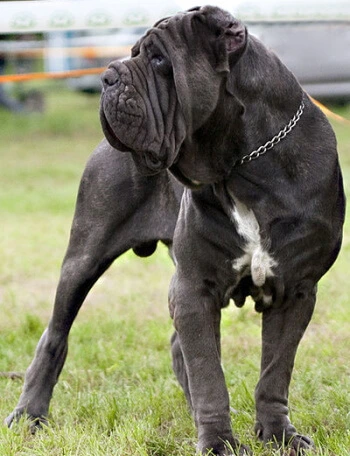 Courtesy E.Ziemska
Courtesy E.ZiemskaThe Neapolitan Mastiff, is a very ancient mastiff dog breed with its origins in Italy though it could well be descended from the Molosser dog of ancient Greece.
Whatever the case, these powerful dogs
ended up in the Roman Empire
at some point
and fought alongside Roman legions.
Appearance and Grooming:
Neapolitan Mastiffs
are typically large and muscular, with males weighing up to 200
pounds and standing up to 31 inches tall at the shoulders.
They have a smooth coat that is short and dense. Coat colors include: black, blue, mahogany, and tawny.
The size of their head and neck can only be described awesome. The ears are often cropped for aesthetic purposes.
Not only large but heavy wrinkles and long folds abound around the muzzle and need regular grooming attention. Wipe this facial area down daily and dry completely to remove any dirt or other unwanted debris.
A minimal amount of brushing is all that is needed to keep their coat clean and manage shedding. Bathe your big boy on an as-needed basis.
Keep nails trimmed, ear cleaned, and teeth brushed daily if you can.
Another aspect of grooming is drooling, and in this case, Neopolitan Mastiffs are in the top 10, so find a way to handle this to your satisfaction. Maybe have a few dog drool rags around.
Background:
The Neapolitan
Mastiff, also known as the Mastino Napoletano in his native country, faced near starvation and extinction at one time due to wars and lack of food.
Fortunately, through the efforts of fanciers, the breed
was rediscovered in Italy in the 1940s and brought back to be enjoyed again.
Due to their history as guard dogs, Neapolitan Mastiffs can be naturally protective of their families and may be wary of strangers. They require a firm and experienced owner who can properly train and socialize them from an early age.
That being said, in general, they are known to be loyal and affectionate with their families and have a calm and patient demeanor.
Exercise and Health:
Neapolitan Mastiffs
require plenty of exercise and space to roam, but they are generally
low energy dogs that are happy to lounge around the house with their
owners.
While being considered a hardy breed with a lifespan of 7 to 10 years, they are disposed to a few health conditions. These include:
- hip
dysplasia - joint malformations common to many large breeds
- cherry eye
- bloat.
Of these, bloat is the most serious and can be life threatening. If an episode of this condition occurs, quick attention by a trusted veterinarian is needed.
The Neo was originally bred as a guard dog and primarily protected estates, homes, and livestock.
Today, they are mostly kept as companion dogs and are known for their loyalty and protective nature.
They can make a great companion for the right family, but they are not recommended for novice dog owners or homes with small children or other pets.
AKC Recognition: The Neopolitan Mastiff breed was recognized by the American Kennel Club as part of the Working Group of dogs in 2004.
Pyrenean Mastiff
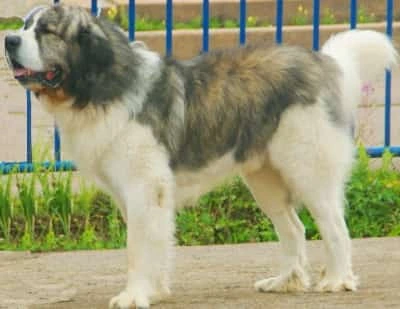
The Pyrenean Mastiff is an ancient breed descended from molosser type dogs believed to have been brought by the Phoenicians to what is now Spain some 3,000 years ago.
It was developed as a livestock guardian breed along with many similar mastiffs bred for the same purpose, such as the Spanish Mastiff, and the Pyrenean Mountain Dog, also known as the Great Pyrenees.
Because the herds of sheep occupied areas populated by large numbers of wolves and bears, these livestock protectors were highly esteemed for the job they performed. For their own protection, they were fitted with spiked collars around their necks for encounters they may have with wolves and bears.
Over the years, with the introduction of mechanized transportation to move animals, the disappearance of predators, plus the occurrence of various wars, the mastiffs almost became extinct. Fortunately, some fanciers came to the rescue to revive the Pyrenean Mastiff.
While they are still considered a rare breed, their numbers have increased significantly around the world.
The Pyrenean Mastiff was recognized by the AKC (American Kennel Club) in 2014 and placed in the Working Dog Group.
Appearance:
The Pyrenean Mastiff is known for its great size and strong build and as some would say: as powerful as the rugged terrain from which he originated!
Height: Males 30-31 inches,
Females 28-30 inches
Weight:
120-190 pounds
Coat colors: White with patches of Black, Golden, Brown, Agouti, Sable, or Gold
The thick, double coat requires frequent brushing to remove loose hair, dirt and dander. A slicker brush is ideal for this purpose. Drooling is on the high side so this needs to be cleaned up quite frequently also.
Characteristics:
Due to their history
as guardian dogs, Pyrenean Mastiffs are naturally protective of their
families and can be wary of strangers though not aggressive.
They are known for being intensely loyal, brave and intelligent.
While being formidable in appearance, the Pyrenean's demeanor is calm, gentle, non-aggressive and even tempered. They make great watchdogs. If sensing a threat to his family pack, he has no trouble recalling his abilities to protect them.
Health Notes:
The
Pyrenean
Mastiff can enjoy a lifespan of 10-12 years with the benefit of good
care and high quality nutrition, daily exercise and veterinary
oversight.
Some health issues to be aware of that may affect the PM breed during its lifetime include:
- Bloat, a life-threatening condition common to large dogs with deep chests.
- Elbow and Hip Dysplasia
- Eye Conditions such as Entropion
Exercise:
Coming from a outdoor working background, the
Pyrenean ideally needs a large outside area to roam about in and sniff
around. In addition, for his health and mental stimulation he should
have a daily walk of up to an hour.
With Children:
Providing
they have been properly socialized,
Pyreneans have a natural affinity for children.
Despite their large size, they are very gentle and patient even with boisterous little ones. However, children should be taught how to interact with pets and not tease or take advantage of their good nature.
Key Points:
- The Pyrenean Mastiff needs a responsible owner who is experienced in training
- Sufficient exercise
- Thorough socialization for this large breed.
They can make a great companion for the right family with the right environment and a good knowledge of the breed.
South African Mastiff
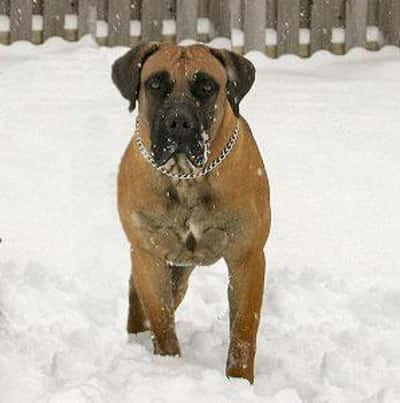 By hunthillboerboels.com
By hunthillboerboels.comHistory of the rare South African Mastiff (SAM), commonly known as the Boerboel, has its roots deeply embedded in South Africa. This breed was initially developed by early settlers, including Dutch, French, and German colonists, who needed a robust and versatile dog to help with a variety of tasks.
These mastiffs were bred for guarding homesteads, protecting livestock, hunting large game, and driving cattle. Their lineage includes the Mastiff-type dogs brought by these settlers and local indigenous breeds, resulting in a dog well-suited to the demanding conditions of South African farms and ranches.
Appearance:
South African Mastiffs (SAMs) are imposing and muscular dogs with a commanding presence.
Height: Males 27 inches,
Females 25 inches
Weight:
150-200 pounds
They possess a short, dense coat that comes in colors such as fawn, brindle, and black. Their broad head is adorned with a strong jaw and, in some cases, cropped ears, though ear cropping is less common today and often considered unnecessary. Their build is robust, with a deep chest and well-defined muscles that reflect their strength and agility.
Characteristics:
South African Mastiffs are known for their formidable presence and natural guarding instincts. They are inherently protective of their family and territory, which makes them excellent guard dogs.
Despite their formidable appearance, they are typically calm and gentle with their families. They exhibit loyalty and affection, along with a patient and composed demeanor.
Training and socialization from an early age are crucial to manage their protective instincts and ensure they are well-adjusted and sociable. These dogs are intelligent and can be independent, so a firm yet gentle approach to training works best.
Exercise:
Boerboels are active and require regular exercise to stay healthy and content. They enjoy activities that engage their strength and stamina, such as daily walks, playtime in a secure yard, and mental stimulation through training exercises or interactive toys.
While they are generally low-key indoors and appreciate lounging around the house, they do need opportunities to expend their energy.
Their exercise needs should be balanced to prevent obesity and maintain their physical fitness, especially given their predisposition to certain joint and digestive issues.
Health Notes:
The South African Mastiff has a life expectancy of 9 to 11 years with the benefit of good care. Like many large breeds, the SAM is prone to specific health concerns. Common issues include:
- Hip dysplasia, a genetic condition that affects the hip joints
- Bloat, a potentially life-threatening condition causing the stomach to expand and twist.
Regular veterinary check-ups, a balanced diet, and maintaining a healthy weight are essential to manage these risks. Early screening and proactive health care can help mitigate some of these issues, ensuring a longer, healthier life for the breed.
With Children:
While South African Mastiffs can be loyal and protective companions, they may not be the best choice for families with very young children. Their size and strength can inadvertently lead to accidents, especially if the dog is not well-trained or socialized.
However, with proper training and supervision, they can get along well with older children, who have familiarity with large breeds and are respectful of them.
While the SAM has a gentle nature, it’s important for interactions between the dog and children to be monitored for the safety of both.
Key Points:
- Requires early training and socialization.
- Needs regular physical activity
- Prone to hip dysplasia and bloat; requires regular veterinary care and proper nutrition.
- Best suited for families with older children due to their size and strength.
The South African Mastiff is a powerful and devoted breed that thrives under the care of a knowledgeable owner. Their loyal nature and protective instincts make them excellent companions for the right environment, where they can receive the attention, exercise, and training they need.
Spanish Mastiff
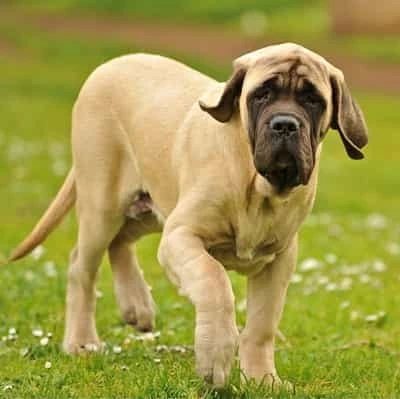 Courtesy C.Gennari
Courtesy C.GennariThe Spanish Mastiff, also known as the Mastín Español or the Mastín Leonés is an ancient breed of dog originating in Spain. It is one of the oldest mastiffs dating back over 2000 years.
Originally bred to be livestock guardian dogs and guardians defending flocks and herds of sheep and other livestock from wolves, bears and other predators.
Today, they are still primarily used as working dogs, but this gentle giant has also become popular as very affectionate family companions.
The Spanish mastiff was recorded in the America Kennel Club Foundation Stock Service in 2008, and is assigned to the Working Dog Group.
Outside of Spain they are a relatively uncommon breed.
Appearance of the Spanish Mastiff Dog Breeds
Spanish Mastiffs are very large in size, powerful and strongly built. Their head is broad coupled with a strong jaw and floppy ears.
Weight:They can weigh up to 200
pounds
Height:
Standing height from the shoulder is 28 to 35 inches
The coat is thick and dense. Among the variety of coat colors that may be seen are: fawn, brindle, red, grey, yellow and black.
One thing to keep in mind is that the Spanish Mastiff is prone to drooling so clean up cloths are a necessity.
Spanish Mastiffs With Family
Based on the Spanish Mastiff's history as a working breed, it is not surprising that protecting their family comes naturally to them. This large breed is very confident and aware of its power when it comes to potential threats.
While the SMs are
not frequent barkers, they will use their their commanding loud bark to
alert you to unusual situations or approaching strangers. I think this
would also tend make visitors take a wait and see approach!
They have a moderately good reputation with children as well as other pets.
Spanish Mastiffs have a calm and patient demeanor and without doubt are very loyal and affectionate with their families.
Training
Because the Spanish Mastiff is a powerful and protective breed, training is vitally important starting from an early age.
They require a firm and experienced owner who can properly train and thoroughly socialize with a positive reinforcement approach.
Well-rounded socialization that exposes them to people, places, situations, as well as other dogs, will help balance their protective nature.
This will ensure they become the great companions you want them to be.
Potential owners are advised to research and understand the breed thoroughly before inviting one into their home.
They can make a great companions for the right family, but they are not recommended for novice dog owners and do best in homes without small children or other pets.
Older children, familiar with and respectful of, pets are an exception.
Exercise and Health
Spanish Mastiffs should have more than one daily walk as well as other forms of exercise including outdoor games, in a fenced area which ideally gives them space to roam.
Other ways to provide more activity include swimming, hiking, and dog sports like agility.
In the home but they are generally mellow dogs that are happy to lounge around the house with their owners.
Spanish Mastiffs are associated with certain health issues, such as hip dysplasia.
Bloat is another serious condition that owners need to watch out for because is common with large chested dogs and needs immediate attention should it occur.
Dogs with the possibility of bloat can have their food placed in special bowls designed to slow down their eating. Plus exercise should not take place around meal times.
Expected lifespan is 10-12 years with a high quality diet, good care and regular veterinary health checks.
Spanish Mastiff - Takeaway
Before deciding on this large breed dog for your family, do thorough research so you don't miss any of the important details.
- Try to have conversations with others who have had a Spanish Mastiff or are very well-informed about the breed.
- Find some experienced professional breeders who can supply references from previous sales of puppies.
- Be sure you can accept a dog that drools!
Tibetan Mastiff
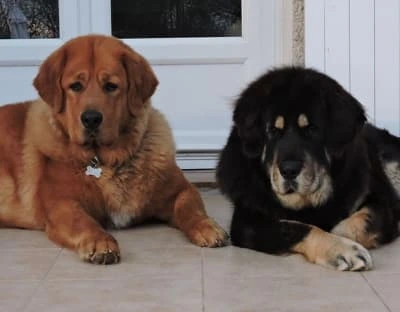 Courtesy Brunodesola
Courtesy BrunodesolaThe Tibetan Mastiff is an ancient mastiff dog breed that originated in Tibet, China and is a real mountain dog who enjoyed a homeland in the high Himalayas and plains of Central Asia. This mastiff breed was also a known breed in Syria and Arabia.
Tibetan Mastiffs are one of the oldest true mastiffs and believed to be the stock from which all mastiff or Molosser breeds and all mountain dogs were developed. In Tibet they are known by the name Do-Kyi (tied Dog) which relates to being tied to the gates of properties and temples.
Later when Queen Victoria received one, it was just identified as a large dog from Tibet. Subsequently, it was officially named by the Kennel Club as Tibetan Mastiff for the first time.
Historically, the TMs were bred to guard properties and protect flocks of sheep from
predators like wolves and snow leopards.
In Tibet, they are tied outside the home during the day and allowed to
run loose at night to protect the property. The Tibetan Mastiff is
considered a primitive breed.
The Tibetan Mastiff is one breed that is very expensive to acquire. In
March of 2011, it was reported that a TM named Hong Dong was purchased
by a wealthy gentleman in China for the sum of $1.52 million! Obviously
this rare breed is not one that many individuals could afford.
In 2006, the TM was made a part of the AKC's Working Group, but it was
President Eisenhower
who is known to have received one of the first Tibetan Mastiffs in the United States as a gift in 1958.

Characteristics of the Tibetan Mastiff
Due to their history as guardians, Tibetan Mastiffs are naturally protective of their families and can be wary of strangers. While their appearance may be intimidating, they would not be aggressive without cause.
Their powerful appearance and size alone would be a deterrent to someone thinking about trespassing.
Despite their natural guarding instincts, loyalty and affection with their families, they are known for their, gentleness, calm and patient demeanor.
However, to help them thrive, this powerful dog requires a firm and experienced owner who can provide the training, exercise, and early socialization they need.
While the Tibetan Mastiff is very intelligent, training can be challenging due to the TM's independent streak. After all, he had to be the decision maker for a long time!
The TM likes being close to his pack and can make a great companion for the right family, but they are not recommended for novice dog owners.
Appearance
Tibetan Mastiffs are some of the largest dogs in the world, with males weighing up to 160 pounds and standing up to 29 inches tall at the shoulder by the time they are 18 months old.
Marco Polo is
said to have described them as the size of a small donkey.
They have a thick, long coat that comes in a variety of colors, including black, brown, and blue-gray. Tibetan Mastiffs have expressive brown eyes and broad head that is set high and surrounded with a thick mane of fur and a strong jaw.
Shedding of this double coat is above average, but twice a year it sheds very heavily, usually spring and fall. Maintenance of the coat will vary according to the time of year, but is important to keep up to avoid mats and skin issues.
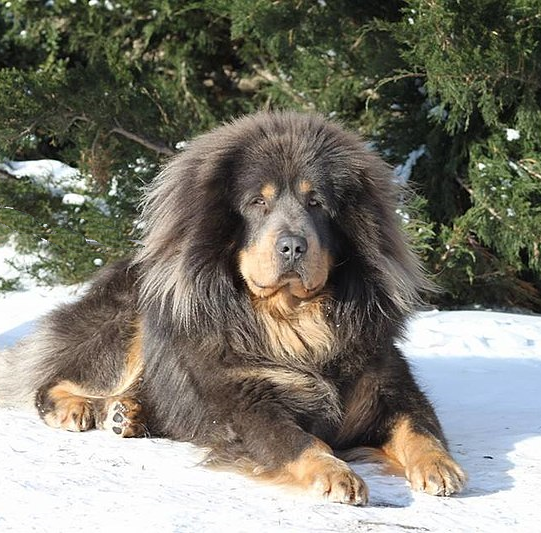 Courtesy Wikimedia
Courtesy WikimediaExercise
Tibetan Mastiffs
do not need a lot of exercise and this is especially true during the first 18 months of growth development.
After they have fully matured, a moderate daily walk will be enjoyed. They are relatively inactive while indoors and happy to lounge around the house.
An outdoor space to roam and sniff around is appreciated.
Health Notes
Tibetan Mastiffs are prone to certain health issues which pet parents should become familiar with. They include:
- Hip dysplasia. This is a painful condition causing a loosening of the hip joints.
- Hot spots. Dogs of this breed frequently experience acute dermatitis, commonly referred to as hot spots.
- Ear infections.
- Eye Disorders such as Entropion and Ectropion.
- Hypothyroidism. This condition occurs due to an under-active thyroid gland and results in hormonal imbalance.
-
PRA
- Progressive retinal atrophy. A degenerative inherited eye disease which can lead to vision loss or blindness.
Pet parents may expect their TM to live up to 12 years with the benefit of a high quality diet, moderate exercise and regular oversight from their veterinarian. Individual lifespans can differ based on genetics and overall care.
Fila Brasileiro
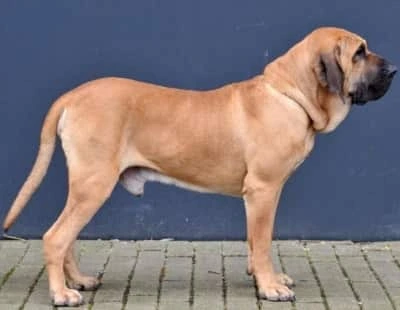 By Doglover
By DogloverThis Fila Brasileiro, otherwise known as the Brazilian Mastiff, is an estate guardian dog from Brazil.
They were originally bred for hunting large game and are known for their strong prey drive and protective nature.
They were also trained to chase down run away slaves.
Breeds that may have been a part of its development include the Bloodhound, the Mastiff and possibly an old type of Bulldog.
The Fila is recognized in Brazil by the Confederação Brasileira de Cinofilia (CBKC), in Puerto Rico by the Federacion Canofila de Puerto Rico (FCPR), and internationally by the Fédération Cynologique Internationale (FCI).
However,
it is not recognized by any major kennel clubs in North America.
Appearance and Grooming:
Fila Brasileiros are
typically large and muscular.
They
have a large head with a powerful jaw, and their ears are often
cropped for aesthetic purposes. Their back line is unusual in that it is not straight but rises up toward the
croup.
Weight: Between 100-130
pounds
Height: Standing up to 29 inches tall at the shoulders
Coat and Colors: They have a short, dense coat that can be black, fawn, or brindle in color.
Maintenance of the coat involves brushing a few times a week to remove dander and control shedding. Bathing can be done on an as needed basis.
Brush the teeth as often as possible, trim nails and inspect ears for parasites and cleaning.
Characteristics:
Fila Brasileiros are
fiercely loyal and protective of their families, and require a firm
and experienced owner who can properly train and socialize them from
an early age.
They have a strong prey drive and may not be suitable for homes with small pets, and they can be wary of strangers and other dogs.
Exercise:
Due to their large
size and high energy levels, Fila Brasileiros require plenty of
exercise and space to roam.
A rural setting is the ideal for this breed where they can be taken for long runs and walks in an area that is secure.
Plan on at least an hour of physical activity each day, but don't overlook mental stimulation for them to
be content. Try puzzle toys to keep them mindfully occupied.
With a background as farm dogs,
they especially enjoy having a job to do.
Health Notes:
Filas are prone to certain genetically inherited health
issues, such as:
- hip and elbow dysplasia - inherited orthopedic conditions
- bloat - a life-threatening condition that needs immediate attention
- entropian - an eyelid condition that needs treatment to avoid eye damage
These issues can be managed through regular veterinary care and monitoring of eating habits and mealtimes.
Responsible breeders will have tested their intended matings to avoid passing along genetic health issues to the puppies.
Takeaway:
The Fila
Brasileiro is a powerful and protective breed that requires a
responsible and experienced owner who can provide the training,
exercise, and socialization.
Extinct Mastiff Dog Breeds
Cuban Mastiff
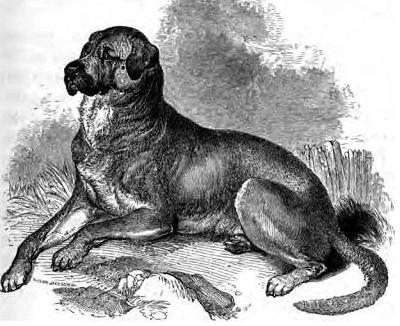 Cuban Mastiff - Wikipedia
Cuban Mastiff - WikipediaThe Cuban Mastiff, also known as Dogo Cubano, Cuban Bloodhound or Cuban Bullmastiff, is an extinct breed which existed in the early 1800's.
It was developed in Cuba from bulldogs, mastiffs and cattle dogs which resulted in the breed bearing a resemblance to the Bullmastiff.
This breed was mainly used to guard properties or as watchdogs and there is some indication they may have participated in bull-baiting or dog fighting as it fits into the profile of dogs in these type activities.
According to Wikipedia, the breed was introduced into Cuba to capture runaway slaves. Subsequently, when slavery was abolished, they ceased to exist.
Alpine Mastiff
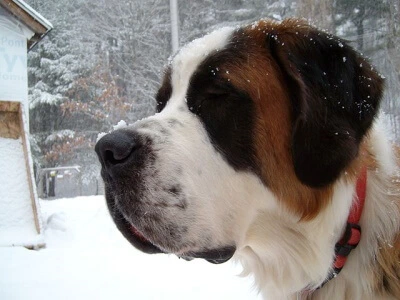 Creative Commons image
Creative Commons imageA breed originating in Switzerland that became extinct during the 19th century.
This breed bears a strong relationship with some of today's mastiff breeds. It was also among those which contributed to the development of the St. Bernard.
Fast Forward
Overall, the rare mastiff dog breeds are enjoying a great deal of interest today.
There are efforts to keep these breeds alive and people interested in owning them all over the world.
The Internet has made it much easier to find out about about these dogs and to contact breeders so hopefully no more rare mastiff dog breeds will become extinct.
Before You Go...
If you like the content of this page, as well as others on my site, please give it some love by clicking on the heart in the lower right hand corner. This helps me to keep providing enjoyable and useful content.
Thank you
Home › AKC Breeds › Mastiff Dog Breeds
Image Credits
- https://commons.wikimedia.org/wiki/File:AlpineMastiff0077.JPG License: https://creativecommons.org/licenses/by/3.0 CC BY
- American Mastiff: https://commons.wikimedia.org/wiki/File:AM.Suma.jpg License: https://creativecommons.org/licenses/by-sa/3.0 CC BY-SA
- https://commons.wikimedia.org/wiki/File:Anatolian_Shepherd_Dog_01.jpg License: https://creativecommons.org/licenses/by-sa/4.0 CC BY-SA
- https://commons.wikimedia.org/wiki/File:Bullmastiff_edited.JPG License: http://creativecommons.org/licenses/by-sa/3.0/ CC BY-SA
- https://commons.wikimedia.org/wiki/File:Cane_corso.jpg License: https://creativecommons.org/licenses/by-sa/3.0/ CC BY-SA
- Dog de Bordeaux from pixabay.com
- English Mastiff: https://commons.wikimedia.org/wiki/File:Westgort_Anticipation_17_months.JPG License: https://creativecommons.org/licenses/by-sa/3.0 /CC BY-SA
- Brazilian Mastiff: https://commons.wikimedia.org/wiki/File:Yacare_De_El_Siledin.JPG License: https://creativecommons.org/licenses/by/3.0 /CC BY-SA
- Great Dane from pixabay.com
- Tosa Inu dog - Japanese Mastiff; https://commons.wikimedia.org/wiki/File:BUKADAI_2.jpg title=via WikimediaCommons BUKADAI..JPG: Ludivine HOUDASderivative work: Caronna License: https://creativecommons.org/licenses/by-sa/3.0 /CC BY-SA
- Neapolitan Mastiff: https://commons.wikimedia.org/wiki/File:Mastino_sylwetka.jpg License: https://creativecommons.org/licenses/by-sa/3.0 /CC BY-SA
- https://commons.wikimedia.org/wiki/File:Pyrenean_Mastiff.JPG License: https://creativecommons.org/licenses/by-sa/3.0>CC BY-SA
- Spanish Mastiff: https://commons.wikimedia.org/wiki/File:Pluto_as_Dumbo_..._(3341583025).jpg License: https://creativecommons.org/licenses/by/2.0 CC BY
- https://commons.wikimedia.org/wiki/File:DOGUE_DU_TIBET_TIBETAN_MASTIFF_DO-KHY.JPG License: https://creativecommons.org/licenses/by-sa/4.0 CC BY-SA
- https://commons.wikimedia.org/wiki/File:136._Cuban_Mastiff.JPG
- Tibetan Paradise, CC BY-SA 4.0 , via Wikimedia Commons

